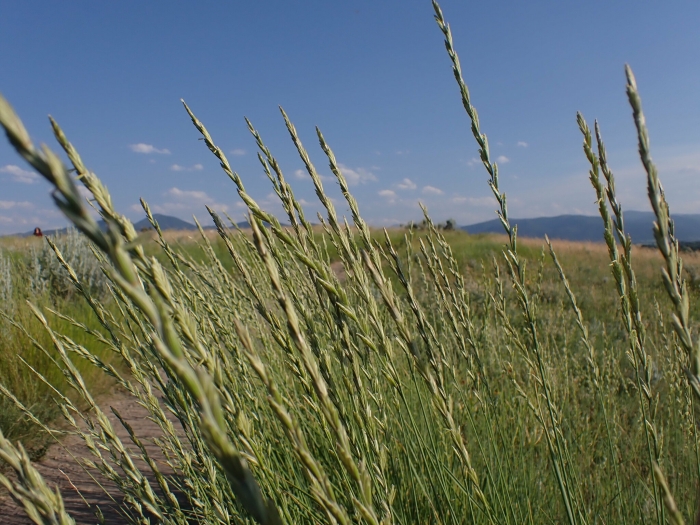Intermediate Wheatgrass
(Thinopyrum intermedium)
Intermediate Wheatgrass (Thinopyrum intermedium)
/
/

Matt Lavin
CC BY 4.0
Image By:
Matt Lavin
Recorded By:
Copyright:
CC BY 4.0
Copyright Notice:
Photo by: Matt Lavin | License Type: CC BY 4.0 | License URL: http://creativecommons.org/licenses/by/4.0/ | Rights Holder: Matt Lavin | Publisher: iNaturalist | Date Created: 2022-07-20T17:43:44-07:00 |
























Estimated Native Range
Summary
Thinopyrum intermedium, commonly known as intermediate wheatgrass, is a sod-forming perennial grass native to temperate regions of Europe and Western Asia, particularly found in meadows, open woodlands, and grasslands. It has been introduced to North America where it is used for forage and soil conservation. Intermediate wheatgrass typically grows up to 5 feet tall and forms dense clumps. It features slender stems and long, narrow leaves, and during its flowering season, which occurs in early to mid-summer, it produces tall, slender spikes with a greenish to purplish hue. The flowers are not particularly showy, but the grass has a graceful appearance when in bloom.
Intermediate wheatgrass is valued for its ability to prevent soil erosion and improve soil structure, making it a useful plant for reclamation projects and sustainable agriculture. It is also beneficial for wildlife habitat, providing cover and food for various species. In cultivation, it requires well-drained soils and can tolerate a range of soil types, from sandy to clay. It is drought-tolerant once established and can persist for many years, with some stands reported to last up to 50 years. While it thrives in full sun, it can also tolerate partial shade. Intermediate wheatgrass is not typically grown for ornamental purposes but is used in pasture mixes, for hay production, and as a cover crop. It has also been the subject of research for its potential as a perennial grain crop when hybridized with wheat. Potential problems include susceptibility to rust diseases and competition with invasive weeds.CC BY-SA 4.0
Intermediate wheatgrass is valued for its ability to prevent soil erosion and improve soil structure, making it a useful plant for reclamation projects and sustainable agriculture. It is also beneficial for wildlife habitat, providing cover and food for various species. In cultivation, it requires well-drained soils and can tolerate a range of soil types, from sandy to clay. It is drought-tolerant once established and can persist for many years, with some stands reported to last up to 50 years. While it thrives in full sun, it can also tolerate partial shade. Intermediate wheatgrass is not typically grown for ornamental purposes but is used in pasture mixes, for hay production, and as a cover crop. It has also been the subject of research for its potential as a perennial grain crop when hybridized with wheat. Potential problems include susceptibility to rust diseases and competition with invasive weeds.CC BY-SA 4.0
Plant Description
- Plant Type: Grass
- Height: 1.5-3 feet
- Width: 2-4 feet
- Growth Rate: Moderate
- Flower Color: N/A
- Flowering Season: Spring
- Leaf Retention: Deciduous
Growth Requirements
- Sun: Full Sun, Part Shade
- Water: Medium
- Drainage: Fast, Medium, Slow
Common Uses
Deer Resistant, Erosion Control, Low Maintenance
Natural Habitat
Native to temperate regions of Europe and Western Asia, particularly found in meadows, open woodlands, and grasslands
Other Names
Common Names: Tall Wheatgrass, Fairway Crested Wheatgrass, Russian Wheatgrass, Pubescent Wheatgrass
Scientific Names: , Thinopyrum intermedium, Agropyron elongatum var. littorale, Agropyron glaucum var. angustifolium, Agropyron glaucum var. intermedium, Agropyron glaucum var. latronum, Agropyron glaucum var. pilosum, Agropyron glaucum var. villiferum, Agropyron goiranicum, Agropyron intermedium
GBIF Accepted Name: